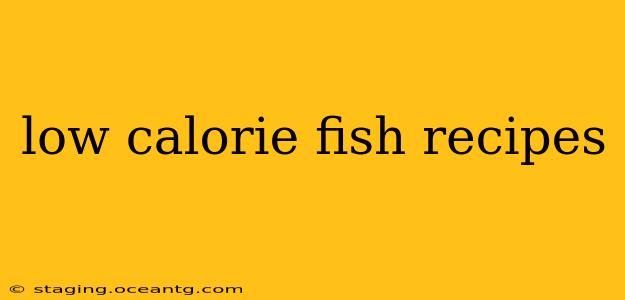Fish is a fantastic source of lean protein and omega-3 fatty acids, making it a cornerstone of any healthy diet. But finding delicious, low-calorie fish recipes can sometimes feel like a challenge. This guide provides a collection of flavorful and nutritious recipes that won't break your calorie bank. We'll explore various cooking methods and flavor profiles, ensuring there's something to tantalize every palate.
What Types of Fish are Lowest in Calories?
Before diving into recipes, let's address a crucial question: which fish offer the most bang for your calorie buck? Generally, white, flaky fish are lower in calories than oily fish. Excellent low-calorie choices include:
- Cod: Mild-flavored and versatile, cod is an excellent base for various recipes.
- Tilapia: Another mild-flavored fish, tilapia is readily available and affordable.
- Haddock: Similar to cod in texture and flavor, haddock is a healthy and delicious option.
- Sole: Delicate and flavorful, sole is perfect for lighter meals.
- Flounder: Another flatfish with a mild flavor, flounder is easy to cook and highly versatile.
How to Prepare Low-Calorie Fish Dishes
The key to keeping fish recipes low in calories lies in your cooking method and added ingredients. Avoid deep-frying and heavy sauces. Instead, opt for:
- Baking: Baking fish in parchment paper or foil helps retain moisture and flavor while minimizing added fat.
- Steaming: Steaming is a healthy way to cook fish, preserving its nutrients and keeping it incredibly light.
- Grilling: Grilling imparts a smoky flavor and creates a delightful texture, just be mindful of oil usage.
- Poaching: Poaching in broth or white wine adds flavor without adding many calories.
Low-Calorie Fish Recipe Ideas
Here are some simple and delicious low-calorie fish recipe ideas to get you started:
Baked Cod with Lemon and Herbs
This classic recipe is incredibly simple yet satisfying. Season cod fillets with salt, pepper, lemon zest, and fresh herbs like dill or parsley. Bake at 400°F (200°C) for 12-15 minutes, or until cooked through. A squeeze of fresh lemon juice before serving adds brightness.
Steamed Tilapia with Ginger and Scallions
Steam tilapia fillets with thinly sliced ginger and scallions for a light and flavorful meal. A splash of soy sauce or rice vinegar adds a nice savory kick, but use sparingly to keep calories low.
Grilled Haddock with Asparagus
Marinate haddock fillets in a mixture of olive oil (use sparingly), lemon juice, garlic, and herbs. Grill alongside asparagus spears for a complete and healthy meal.
Lemon-Garlic Poached Sole
Poach sole fillets in a mixture of white wine, lemon juice, garlic, and a bay leaf. The delicate flavor of the sole is beautifully complemented by the bright and savory poaching liquid.
Frequently Asked Questions
What are the best side dishes for low-calorie fish?
Steamed or roasted vegetables like broccoli, asparagus, green beans, or Brussels sprouts are excellent low-calorie side dishes for fish. A simple salad with a light vinaigrette is another healthy option. Quinoa or brown rice can also be incorporated in moderation.
Can I freeze leftover cooked fish?
Yes, you can freeze leftover cooked fish. Store it in an airtight container in the freezer for up to three months.
How do I know when fish is cooked through?
Fish is cooked through when it flakes easily with a fork and is opaque throughout. Avoid overcooking, as this can make the fish dry.
Are there any low-calorie fish sauces I can use?
Lemon juice, herbs, spices, and a small amount of olive oil or light soy sauce can add delicious flavor to fish without significantly increasing the calorie count. Avoid creamy sauces and heavy dressings.
How many calories are in a typical serving of fish?
The calorie count of a serving of fish varies depending on the type of fish, portion size, and cooking method. However, a 3-4 ounce serving of most low-calorie white fish typically contains between 100-150 calories.
By following these tips and trying out these delicious recipes, you can enjoy healthy and flavorful low-calorie fish meals that support your weight management goals and overall well-being. Remember to always check nutrition labels and adjust portion sizes to meet your individual dietary needs.
